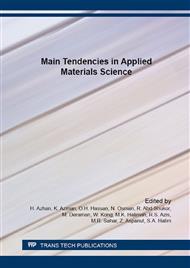[1]
F. A. Abdel-Mohdy, E. S. Abdel-Halim, Y. M. Abu-Ayana, and S. M. El-Sawy, Rice straw as a new resource for some beneficial uses, Carbohydr. Polym., vol. 75, no. 1, p.44–51, Jan. (2009).
DOI: 10.1016/j.carbpol.2008.06.002
Google Scholar
[2]
R. Khandanlou, M. Bin Ahmad, K. Shameli, and K. Kalantari, Synthesis and characterization of rice straw/Fe3O4 nanocomposites by a quick precipitation method., Molecules, vol. 18, no. 6, p.6597–607, Jan. (2013).
DOI: 10.3390/molecules18066597
Google Scholar
[3]
P. J. Van Soest, Rice straw, the role of silica and treatments to improve quality, Anim. Feed Sci. Technol., vol. 130, no. 3–4, p.137–171, Nov. (2006).
DOI: 10.1016/j.anifeedsci.2006.01.023
Google Scholar
[4]
R. Sun, J. Tomkinson, F. C. Mao, and X. F. Sun, Physicochemical characterization of lignins from rice straw by hydrogen peroxide treatment, J. Appl. Polym. Sci., vol. 79, no. 4, p.719–732, Jan. (2001).
DOI: 10.1002/1097-4628(20010124)79:4<719::aid-app170>3.0.co;2-3
Google Scholar
[5]
K. L. Kadam, L. H. Forrest, and W. A. Jacobson, Rice straw as a lignocellulosic resource: collection, processing, transportation, and environmental aspects, Biomass and Bioenergy, vol. 18, no. 5, p.369–389, May (2000).
DOI: 10.1016/s0961-9534(00)00005-2
Google Scholar
[6]
M. Magallanes-perdomo, Z. B. Luklinska, A. H. De Aza, R. G. Carrodeguas, S. De Aza, and P. Pena, Bone-like forming ability of apatite – wollastonite glass ceramic, J. Eur. Ceram. Soc., vol. 31, no. 9, p.1549–1561, (2011).
DOI: 10.1016/j.jeurceramsoc.2011.03.007
Google Scholar
[7]
X. Liu, C. Ding, and P. K. Chu, Mechanism of apatite formation on wollastonite coatings in simulated body fluids, Biomaterials, vol. 25, no. 10, p.1755–1761, May (2004).
DOI: 10.1016/j.biomaterials.2003.08.024
Google Scholar
[8]
L. Zhao and J. Chang, Preparation and characterization of macroporous chitosan/wollastonite composite scaffolds for tissue engineering., J. Mater. Sci. Mater. Med., vol. 15, no. 5, p.625–9, May (2004).
DOI: 10.1023/b:jmsm.0000026103.44687.d0
Google Scholar
[9]
P. Kalla, A. Misra, R. C. Gupta, L. Csetenyi, V. Gahlot, and A. Arora, Mechanical and durability studies on concrete containing wollastonite–fly ash combination, Constr. Build. Mater., vol. 40, p.1142–1150, Mar. (2013).
DOI: 10.1016/j.conbuildmat.2012.09.102
Google Scholar
[10]
S. Ke, X. Cheng, Y. Wang, Q. Wang, and H. Wang, Dolomite, wollastonite and calcite as different CaO sources in anorthite-based porcelain, Ceram. Int., vol. 39, no. 5, p.4953–4960, Dec. (2013).
DOI: 10.1016/j.ceramint.2012.11.091
Google Scholar
[11]
M. Felipe-Sesé, D. Eliche-Quesada, and F. a. Corpas-Iglesias, The use of solid residues derived from different industrial activities to obtain calcium silicates for use as insulating construction materials, Ceram. Int., vol. 37, no. 8, p.3019–3028, Dec. (2011).
DOI: 10.1016/j.ceramint.2011.05.003
Google Scholar
[12]
X. -H. Huang and J. Chang, Synthesis of nanocrystalline wollastonite powders by citrate–nitrate gel combustion method, Mater. Chem. Phys., vol. 115, no. 1, p.1–4, May (2009).
DOI: 10.1016/j.matchemphys.2008.11.066
Google Scholar
[13]
X. Wan, C. Chang, D. Mao, L. Jiang, and M. Li, Preparation and in vitro bioactivities of calcium silicate nanophase materials, Mater. Sci. Eng. C, vol. 25, no. 4, p.455–461, Jun. (2005).
DOI: 10.1016/j.msec.2004.12.003
Google Scholar
[14]
L. Z. Pei, L. J. Yang, Y. Yang, C. G. Fan, W. Y. Yin, J. Chen, and Q. F. Zhang, A green and facile route to synthesize calcium silicate nanowires, Mater. Charact., vol. 61, no. 11, p.1281–1285, Nov. (2010).
DOI: 10.1016/j.matchar.2010.07.002
Google Scholar
[15]
F. Tamimi, D. Le Nihouannen, H. Eimar, Z. Sheikh, S. Komarova, and J. Barralet, The effect of autoclaving on the physical and biological properties of dicalcium phosphate dihydrate bioceramics: brushite vs. monetite., Acta Biomater., vol. 8, no. 8, p.3161–9, Aug. (2012).
DOI: 10.1016/j.actbio.2012.04.025
Google Scholar
[16]
H. Ismail, R. Shamsudin, M. A. Abdul Hamid, and A. Jalar, Synthesis and Characterization of Nano-Wollastonite from Rice Husk Ash and Limestone, Mater. Sci. Forum, vol. 756, p.43–47, May (2013).
DOI: 10.4028/www.scientific.net/msf.756.43
Google Scholar
[17]
D. S. Klimesch and A. Ray, The use of DTA / TGA to study the effects of ground quartz with different surface areas in autoclaved cement : quartz pastes . Use of the semi-isothermal thermogravimetric technique, Thermochim. Acta, vol. 306, p.159–165, (1997).
DOI: 10.1016/s0040-6031(97)00279-7
Google Scholar
[18]
D. S. Klimesch and A. Ray, The use of DTA / TGA to study the effects of ground quartz with different surface areas in autoclaved cement ' quartz pastes . Part 1 ' A method for evaluating DTA / TGA results, Thermochim. Acta, vol. 289, p.41–54, (1996).
DOI: 10.1016/s0040-6031(96)03033-x
Google Scholar
[19]
R. Abd Rashid, R. Shamsudin, M. A. Abdul Hamid, and A. Jalar. 2014. In-vitro bioactivity of wollastonite materials derived from limestone and silica sand, Ceram. Int., 40; 6847–6853.
DOI: 10.1016/j.ceramint.2013.12.004
Google Scholar
[20]
R. P. Sreekanth Chakradhar, B. M. Nagabhushana, G. T. Chandrappa, K. P. Ramesh, and J. L. Rao, Solution combustion derived nanocrystalline macroporous wollastonite ceramics, Mater. Chem. Phys., vol. 95, no. 1, p.169–175, Jan. (2006).
DOI: 10.1016/j.matchemphys.2005.06.002
Google Scholar
[21]
C. Paluszkiewicz, M. Blażewicz, J. Podporska, and T. Gumuła, Nucleation of hydroxyapatite layer on wollastonite material surface: FTIR studies, Vib. Spectrosc., vol. 48, no. 2, p.263–268, Nov. (2008).
DOI: 10.1016/j.vibspec.2008.02.020
Google Scholar
[22]
P. Kolhe and R. M. Kannan. 2003. Improvement in ductility of chitosan through blending and copolymerization with PEG: FTIR investigation of molecular interactions, Biomacromolecules, 4; 173–180.
DOI: 10.1021/bm025689+
Google Scholar


